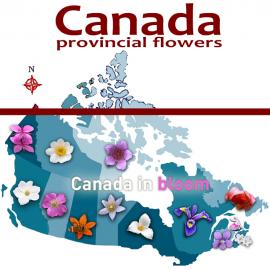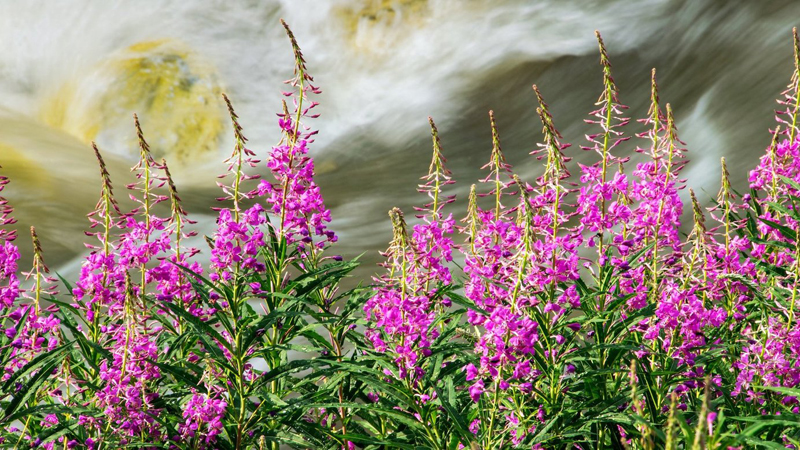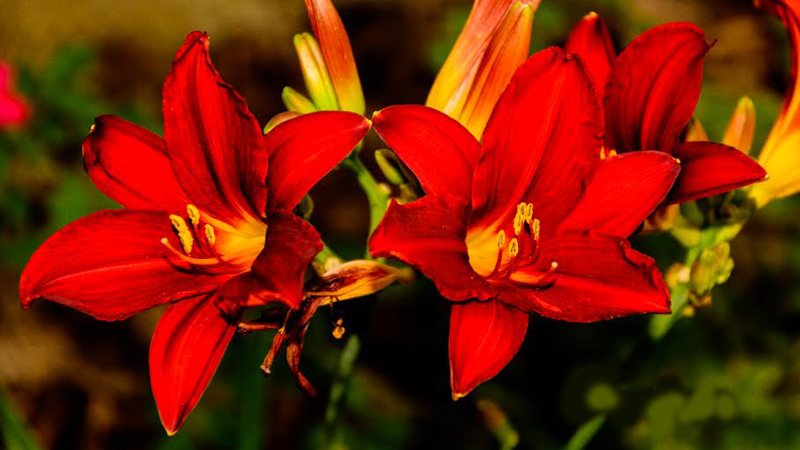
- Floral Services
- About
- Pricing
- Preservation
-
Portfolio
- Pumpkin Flowers Gallery
- Commercial Floral Gallery
- Scent Free Arrangement's
- Wedding Flowers
- Rental Furniture or Equipment
- EZ Vase
- Gifts & Gift Basket Gallery
- Jewelry & Bridal Accessories
- Just Flowers Gallery
- Budding Impressions 2011
- Budding Impressions 2012
- Budding Impressions 2014
- Budding Impressions 2015
- Contact

Canada In Bloom
Unique flower emblems represent the Canadian
provinces and territories. These symbols represent the sovereignty and the
various provincial identities. They express the different features of a
province or territory. The provincial floral symbols account for the flowers that grow in that area. Get to know Canada below.

1. Yukon - Fireweed
The Fireweed (Epilobium
angustifolium) flower got its name because it is the first plant to grow
abundantly in areas struck by forest fire. Plants like this are called “pioneer
species” because they grow in land that has been disturbed. After trees regrow
to shade the area, the Fireweed no longer gets enough sun, but its seeds stay
in the ground. When another forest fire passes through, the seeds germinate,
and the Fireweed flower grows and blooms once again.
Fireweed is the
official flower symbol of Yukon, Canada chosen in 1957.
It grows along
Yukon roadsides, river bars and clearings from mid-July to September. Some
parts of Canada recognize the fireweed as the Great Willow Herb. The fireweed
has a reddish stem that rises to a height of about 2.5 m and has leaves that
are scattered and spirally arranged. The flower is edible. The fleshy part
inside the young stems of the Fireweed is delicious, and its leaves can be made
into an infusion rich in vitamins A and C. Bees adore Fireweed flowers and
produce a liquid gold Fireweed honey.

2. Northwest Territories - Mountain Avens Flower
The Mountain
Avens (Dryas octopetala), was adopted in 1957. The creamy-white flower, which
is a member of the rose family, grows in the Eastern and Central Arctic on
high, barren rocky ground. It has narrow basal leaves and supports a single
bloom on a short stem. This flower is an
Arctic-alpine flowering evergreen subshrub in Rosacea family. The name
octapetala comes from its eight petals that are a unique feature from the rest
of the Rosacea family. The Dryas octopetala is diverse in the mountainous
regions dominating the Arctic regions, the Scandinavia mountainous region, and
the Canadian Rockies. The Northwest Territories of Canada recognizes the Dryas
octopetala as its official floral emblem.

Apart from being
from the rose family the Mountain Avens Flower will seed a blossom like puff of cloud, ready to be blown and spread by the wind. See above.

3. Saskatchewan - Western red lily
Western Red Lily
(Lilium philadelphicum), was chosen in 1941.
It is also known as the wood lily, Philadelphia lily, Prairie lily or
Western Red lily, and it is a perennial species of lily native to North
America. Native Americans relied on the wood lily bulb as a source of food.
Used as a substitute for potato and a thickener for soups, its sweet flavor and
high starch content added flavor and nutrition. As a medicinal plant, wood lily
bulbs are steeped in tea as an herbal remedy for coughs, fever and stomach
ailments. Crushed wood lily bulbs made into a poultice are thought to bring
relief to swellings, bruises, sores and wounds and has been used as a remedy
for spider bites.
The Western Red
Lily is diverse in Canada dominating British Columbia and Quebec. This lily
species grows to a height of about 30-90 cm and produces orange or red flowers
between June and August. The Western Red Lily is now an endangered species as
the flower which once grew abundantly in open fields has been cut and plowed
down for farm land. The Western Red Lily is the provincial floral emblem of
Saskatchewan and is seen on the Provincial Flag.

4. Quebec - Blue flag iris
The blue flag
(iris versicolor) is the floral emblem of Quebec, as per the Flag and Emblems
of Quebec Act November 5, 1999. Scientifically known as the Iris versicolor is
native to North America and diverse in Eastern Canada and the Eastern United
States. The Iris stems from a plant which Native Americans used to make
medicine specifically from the underground stem (rhizome). The blue flag was
used as a laxative and to relieve fluid retention and bloating. It was also
used to treat swelling (inflammation) and skin conditions; and to prevent
vomiting. Some people use it for liver problems and to increase bile
production. But we don’t recommend experimenting.
4. Prince
Edward Island - Lady's slipper
The Lady's
Slipper (Cypripedium) was made the official provincial flower on April 25,
1947. The orchid gets its name from the shape of its petals which look like a
slipper. The Lady's Slipper blooms in late May and June and grows in shady
woodlands. These delicate flowers should not be picked or moved because they
rarely survive a change of habitat. The pink lady’s slipper is an orchid from
the genus Cypripedium. The lady’s slipper is diverse in Canada, as it inhabits
every province except British Columbia. The lady’s slipper plant has two leaves
that are close to the ground and a stalk that sprouts to hold a single pink
flower. Prince Edward Island in Canada uses the pink lady’s slipper as the
official flower symbol.
5. Ontario -
White trillium
White trillium
(Trillium grandiflorum,) flowers Apr-May in the hardwood forests of western and
central Québec and in the lower Ottawa Valley, Ont. It has been the Provincial
Floral Emblem in Ontario since 1937.Trillium grandiflorum is a species of
flowering perennial herbaceous plant that is native to North America ranging
from the northern Quebec to the south of the United States. In Canada, this
plant is also diverse in British Columbia. The white trillium is famous for its
three-petaled white flowers. The flower is the official provincial emblem of
Ontario, Canada and is featured on the province’s official flag.
6. Nunavut -
Purple saxifrage
Purple
Saxifrage. (Saxifraga oppositifolia) was unanimously adopted by the Legislative
Assembly of Nunavut on May 1, 2000, as the official flower of Nunavut. This
wildflower is one of the three wildflowers depicted on Nunavut's coat of arms,
is a species of a low-growing edible plant found in the Arctic and high
mountainous regions. The plant grows to about 3-5 cm and has woody branches
that lie close to the ground. The plant flowers during the spring to the
summer. It thrives in environments ranging from cold temperatures to arctic
habitats. The purple saxifrage is the flower symbol of Nunavut, Canada.
7. Nova Scotia -
Mayflower
The Mayflower (Trailing arbutus), is a shrub in the family Ericaceae. The Nova Scotia Colony is a member group of the Canadian Society of Mayflower Descendants, and membership is open to all who are interested in the Mayflower, its history and particularly the passengers who came on the boat in 1620 to New England. Its habitats range from Newfoundland to Kentucky. The plant does well in moist and acidic soil. The flowers of the Mayflower are pink and fade to almost white. In Canada, the Mayflower is the emblem of Nova Scotia.
9. Newfoundland
and Labrador - Purple pitcher plant
Purple Pitcher
Plant (Sarraceniaceae). In 1954 the
Newfoundland Cabinet designated this interesting plant as the official flower
of the province. The pitcher plant gets its nourishment from insects that are
trapped and drown in a pool of water at the base of its tubular leaves. Its habitat
ranges from the Eastern Seaboard and the Gulf Coast of the United States, all
regions of Canada except Nunavut and Yukon, Alaska, and Washington State. The
purple pitcher plant thrives in the cold temperate climates. Like all other
carnivorous plants, the purple pitcher plant obtains its nutrients from prey
capture. This species of the pitcher is the floral emblem of Newfoundland,
Canada.
10. New Brunswick
- Purple violet
Purple Violet
(Violaceae). The flower was adopted as
the New Brunswick floral emblem in 1936, at the request of the provincial
Women's Institute, the Lieutenant Governor and New Brunswick schoolchildren.
The Purple Violet is the largest genus in the family Violaceae as it has
species of somewhere in between 525-600. Most species of the Viola are
widespread in the temperate Northern Hemisphere. Some species are perennial,
others are annual, and a few are shrubs. The viola has heart-shaped leaves and
flowers that rise from the ground. The colors of the viola flowers range from violet,
to shades of blue, white, yellow, and cream. The purple violet is the national
emblem of New Brunswick.
11. Manitoba -
Prairie crocus
Prairie Crocus.
In Manitoba, the prairie crocus (Pulsatilla ludoviciana) also known as anemone
patens, the pasque-flower, the windflower (because of its furry petals) and the
gosling plant This is a flowering plant
from Ranunculaceae family This flower
was officially adopted as the official flower in 1906 and is native to Canada,
Europe, China, Mongolia, Russia, and the United States. The population of
prairie crocus is reducing due to the interaction between the shortgrass
prairie and the prairie crocus ecosystems. In the Canadian province of Manitoba
province the Prairie Crocus is its official flower.
12. British
Columbia - Pacific dogwood
The Pacific
dogwood also has names such as the Western dogwood, the California dogwood, or
the mountain dogwood. This dogwood species is native to the western North
America from the British Columbia to California. The Pacific dogwood ranges
from small to medium size and rises to a height of about 10-25 m tall. There
can be 8-12 leaves on this plant. British Columbia uses the Pacific dogwood as
its official flower emblem.
13. Alberta -
Wild rose
The scientific
name of the wild rose is Rosa acicularis. Other names the flower is referred to
include the prickly rose, prickly wild rose, bristly rose, and the Arctic rose.
The Rosa acicularis is diverse in North America, Asia, and Europe. This plant
is a deciduous shrub that grows to a height of about 1-3 m tall and has pinnate
leaves. The wild rose has pink flowers and is the official provincial flower of
Alberta province in Canada.